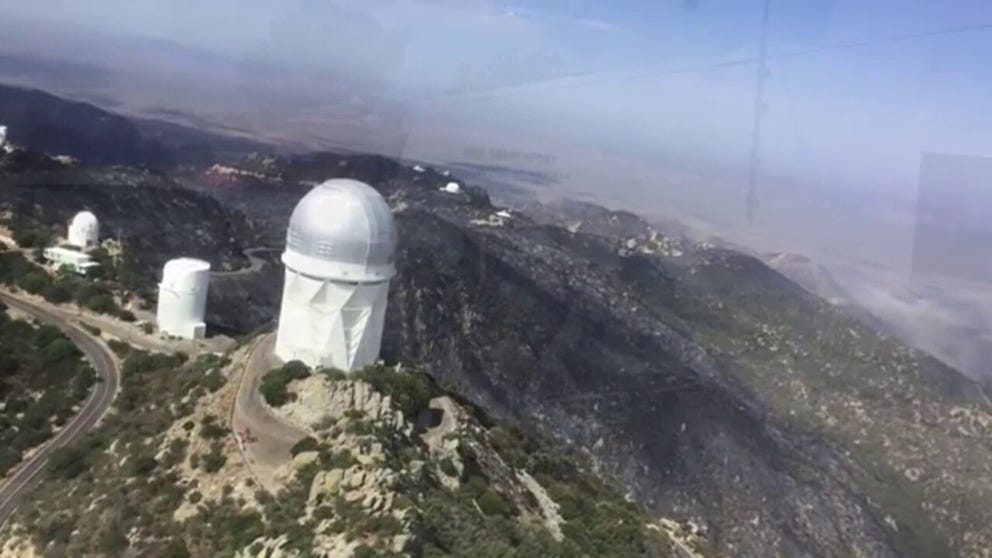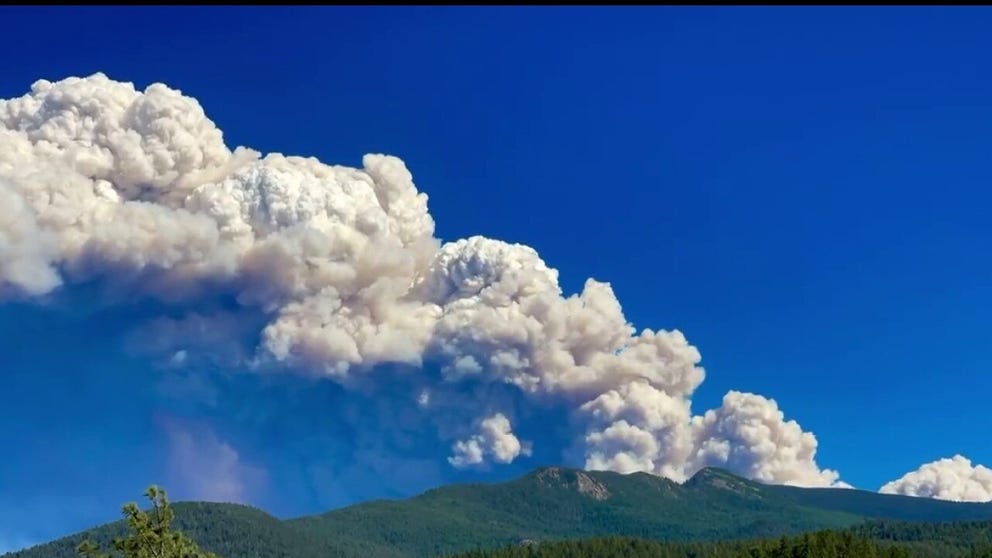America ablaze: Wildfires scorch more than 3.2 million acres of land from coast to coast
Firefighters hoping arrival of monsoonal moisture will allow them to gain ground on firefighting efforts in the Southwest
Mullica River Fire burns around 13,500 acres
According to the New Jersey Forest Fire Service, the Mullica River Fire has burned around 13,500 acres. FOX Weather's Max Gorden with more from Los Angeles.
Large wildfires have been ravaging the United States from Alaska to the southwestern United States and East Coast, scorching more than 3.2 million acres of land this year, according to the National Interagency Fire Center.
HOW TO WATCH FOX WEATHER ON TV
Large parts of the country have faced extremely dry conditions, creating the perfect fuels for fires to quickly grow in size and spread when they ignite.
And with several fires burning in the southwestern United States, the start of monsoon season is welcome news for the thousands of firefighters who have been working tirelessly to extinguish the blazes.
Here's a closer look at some of the bigger fires burning across the country.
SOUTHWEST MONSOON SEASON IS HERE: HERE'S WHAT YOU NEED TO KNOW
Alaska

(FOX Weather)
There are at least 118 large wildfires burning across the state of Alaska in what has been the most active start to the fire season since 2019.
One million acres of land have been burned so far this year.
Rain has been able to help slow the spread of some fires, including the Fish Fire, which is currently burning along the west side of the Dalton Highway near milepost 116.

The Fish Fire burning west of the Dalton Highway is seen from the air on June 20, 2022. The Arctic Circle Wayside can be seen on the right side of the photo.
(Ezra Butterfield, BLM Alaska Smokejumper / FOX Weather)
The Bureau of Land Management Central Yukon Field Office said it closed the Arctic Circle campground. Campers were directed to other Dalton Highway campgrounds, including Five Mile at milepost 60, Marion Creek at milepost 180 and Galbraith Lake Campground at milepost 275.
The fire, which was caused by lightning, was last reported to be about 295 acres in size.
And while rain and firefighting efforts continue to help prevent the expansion of wildfires, two additional blazes broke out over the weekend.
The Nunavulnuk River Fire is located 20 miles south of Saint Michael on the northern side of the Nunavulnuk River. Officials warn that this fire has the potential for large wildfire growth.
A second fire, the Vachon Fire, also broke out over the weekend. It is located on Vachon Island in the Yukon River, about 20 miles west of Manley Hot Springs.
For the latest information on the fires burning in Alaska, check out the Alaska Wildland Fire Information website by clicking here.
HOW THE LAY OF THE LAND AFFECTS WILDFIRE BEHAVIOR
Arizona
Kitt Peak Observatory still standing after wildfire close call
Video from the Arizona Bureau of Land Management shows the telescopes and science buildings are still standing at the Kitt Peak National Observatory amid an ongoing wildfire.
Three major wildfires continued to burn in Arizona.
The Contreras Fire burning on the Tohono O’odham Indian Reservation about 1 hour outside of Tucson has grown to 27,91 acres as of Tuesday night with 50% containment.
The wildfire continues to burn close to Kitt Peak National Observatory, a 60-year-old facility part of the National Science Foundation’s NOIRLab. Over the weekend, the fire ran up the slope of Kitt Peak and four buildings part of the facility were lost, but no telescopes have burned yet.
Firefighters are still working to contain the fire, which has been fueled by challenging terrain, triple-digit temperatures and low relative humidity.
Near Flagstaff, evacuations remain in place for the Pipeline and Haywire fires.
The Pipeline Fire burning 6 miles north of Flagstaff has scorched 26,532 acres with 70% containment.
On Monday, rain and fire suppression actions improved conditions to contain the fire, according to Coconino National Forest officials.
The Haywire Park Fire, about 7 miles northeast of Doney Park, has reached 5,575 acres with 40% containment.
Across Arizona, more than 950 personnel, including 11 hotshot crews, continue the firefight.
WHAT YOU SHOULD KEEP IN YOUR EVACUATION ‘GO’ BAG DURING WILDFIRE SEASON
New Jersey
Watch: Wildfire rages in New Jersey
Firefighters are working to contain and extinguish a large wildfire burning in Wharton State Forest, located in Washington Township, New Jersey.
The Mullica River Fire burning in the Wharton State Forest in New Jersey is now the largest wildfire the state has seen in 15 years.
The fire has consumed about 13,500 acres of land and is 85% contained as of late Tuesday morning.
The good news is that firefighters had made significant progress in containing and extinguishing the blaze, allowing officials to reopen roads shut down when the fire raged.
Unfortunately, many public recreation areas will remain closed for the foreseeable future.
No injuries or deaths have been reported because of the fire.
HOW WILDFIRE BURN SCARS COULD HAVE LASTING IMPACTS
New Mexico
Massive pyrocumulus cloud forms from Calf Canyon/Hermits Peak Fire
Massive pyrocumulus cloud forms in Sante Fe, New Mexico as result of the Calf Canyon/Hermits Peak Fire. (Video: Garrett VeneKlasen / Weather Traker / TMX)
Several large wildfires are currently burning in New Mexico, including what are now the two largest fires the state has ever seen - the Hermits Peak and Calf Canyon Fire and the Black Fire.

(FOX Weather)
Since late April, more than 700 buildings and homes have been destroyed amid the raging wildfires, with both blazes burning a combined total of more than 660,000 acres of land.

(FOX Weather)
The Hermits Peak Fire and Calf Canyon Fire began as two separate fires when they broke out in early April but merged into one large fire.
As of Tuesday afternoon, the fire has burned 341,471 acres of land and is 72% contained.
CLICK HERE TO GET THE FOX WEATHER UPDATE PODCAST

(FOX Weather)
And the Black Fire, which is burning within the Gila National Forest, has burned 325,115 acres since it began on May 13.
It's currently only at 63% containment, but the hope is that the monsoonal moisture will help firefighters gain ground on extinguishing the blazes.



